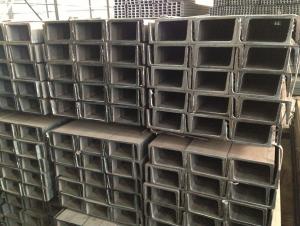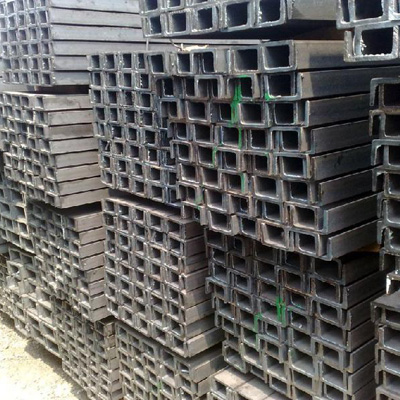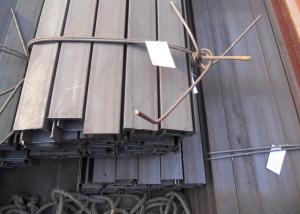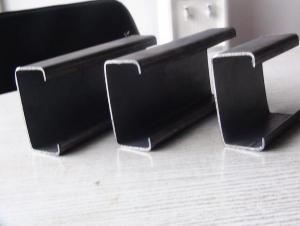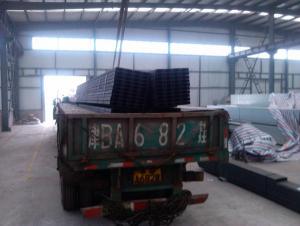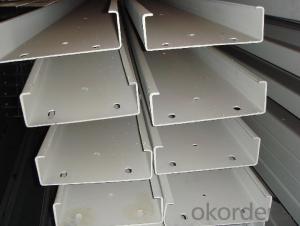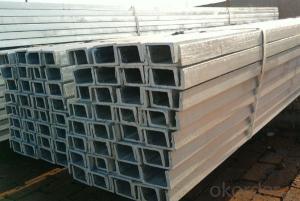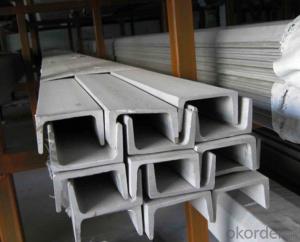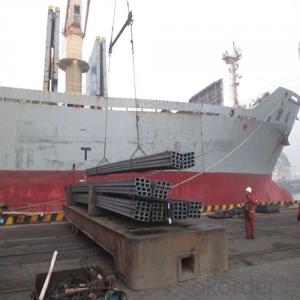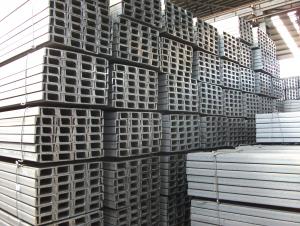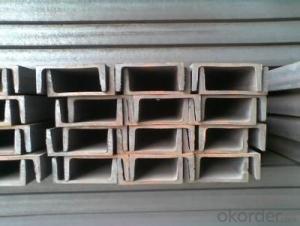GB Steel Channel Q235 With High Quality
- Loading Port:
- China main port
- Payment Terms:
- TT or LC
- Min Order Qty:
- 25 m.t
- Supply Capability:
- 2000 m.t/month
OKorder Service Pledge
OKorder Financial Service
You Might Also Like
Product Applications:
GB Steel Channel Q235 With High Quality re ideal for structural applications and are widely used in the construction of buildings and bridges, and the manufacturing, petrochemical, and transportation industries.
Product Advantages:
OKorder's GB Steel Channel Q235 With High Quality are durable, strong, and resist corrosion.
Main Product Features:
· Premium quality
· Prompt delivery & seaworthy packing (30 days after receiving deposit)
· Corrosion resistance
· Can be recycled and reused
· Mill test certification
· Professional Service
· Competitive pricing
The steel u channel will be packed in bundle with steel wire at each end of every bundle and color marking in order to help the customer to recognize his goods more easily at sight.
And steel u channel could be loaded into 20ft or 40ft container, or by bulk cargo. If the weight of each bundle reaches less than 3.5 mt, the loading by break bulk cargo should be choosed. When the weight of each bundle reaches less than 3mt, the loading by container should be choosed.
As for the transportaion from mill to loading port, the truck will be usually used. And the maximum quantity for each truck is 40mt.
All in all, we could do in accordance with customer's request.
Trade terms: FOB, CFR, CIF
FAQ:
Q1: Why buy Materials & Equipment from OKorder.com?
A1: All products offered byOKorder.com are carefully selected from China's most reliable manufacturing enterprises. Through its ISO certifications, OKorder.com adheres to the highest standards and a commitment to supply chain safety and customer satisfaction.
Q2: How do we guarantee the quality of our products?
A2: We have established an advanced quality management system which conducts strict quality tests at every step, from raw materials to the final product. At the same time, we provide extensive follow-up service assurances as required.
Q3: How soon can we receive the product after purchase?
A3: Within three days of placing an order, we will begin production. The specific shipping date is dependent upon international and government factors, but is typically 7 to 10 workdays.
Images:
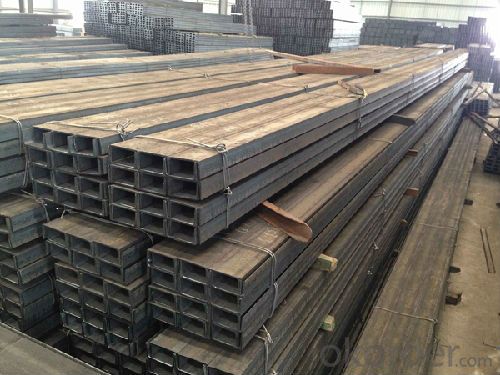
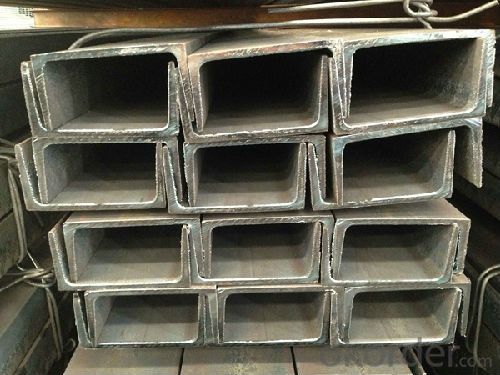
- Q: How do you calculate the moment of inertia for steel channels?
- The moment of inertia for steel channels can be calculated using the standard formula for the moment of inertia of a beam. This formula takes into account the dimensions of the channel and the distribution of its mass. The specific formula for calculating the moment of inertia of a steel channel can be found in engineering handbooks or online resources.
- Q: Channel structure, angle steel, I-beam and so on, if not painted, the impact on life?
- Influence, without paint, easy to rust, will reduce life, strength will be affected.
- Q: What are the different load distribution techniques for steel channels?
- Steel channels can be subjected to different load distribution techniques. 1. One technique is the uniform load distribution, which evenly distributes the load across the entire length of the steel channel. This method is suitable for cases where the load is evenly distributed or when there isn't a specific point of concentrated load. 2. Another technique is concentrated load distribution, where the load is concentrated at specific points along the steel channel. This is commonly used in areas where the load is expected to be higher, such as support points or connection joints. 3. Variable load distribution is a technique that involves varying the load distribution along the length of the steel channel. It is used when the load is not evenly distributed and varies from one point to another. This can be achieved by adjusting the spacing between the supports or implementing additional support mechanisms like beams or braces. 4. Sometimes, a combination of load distribution techniques is employed to optimize the structural integrity of the steel channel. This may involve using uniform load distribution for the majority of the length, while concentrated load distribution is utilized at specific points where the load is expected to be higher. Various factors, including the nature of the load, structural requirements, and the intended use of the steel channel, should be taken into account when choosing a load distribution technique. Consultation with a structural engineer is crucial to determine the most suitable load distribution technique for a specific application.
- Q: What are the common connections used for steel channels?
- The common connections used for steel channels include welding, bolting, and using mechanical connectors such as clevis hangers or strut fittings.
- Q: Are steel channels suitable for use in the construction of storage racks?
- Yes, steel channels are suitable for use in the construction of storage racks. Steel channels are commonly used in the construction industry due to their strength and durability. They provide excellent support and stability for storage racks, allowing them to hold heavy loads without bending or warping. Additionally, steel channels can be easily customized to fit specific storage needs, making them a versatile choice for constructing storage racks. The corrosion resistance of steel also ensures that the racks will last for a long time, even in harsh environments. Overall, steel channels are a reliable and suitable option for use in the construction of storage racks.
- Q: What are the different methods for connecting steel channels?
- There are several methods for connecting steel channels, each with its own advantages and applications. Some of the commonly used methods include: 1. Welding: Welding is one of the most common methods for connecting steel channels. It involves melting the two adjoining surfaces and joining them together using a similar or compatible metal filler material. Welding provides a strong and permanent connection, making it suitable for structural applications. 2. Bolting: Bolting involves using bolts, nuts, and washers to connect steel channels. This method is relatively easier and quicker compared to welding. Bolting provides a flexible connection, allowing for disassembly and reassembly if needed. It is commonly used in applications where frequent maintenance or adjustments are required. 3. Riveting: Riveting is a method of connecting steel channels using rivets, which are cylindrical metal pins. The rivets are inserted through pre-drilled holes in the channels and then hammered or compressed to secure them in place. Riveting provides a sturdy and reliable connection and is often used in heavy-duty applications. 4. Adhesive bonding: Adhesive bonding involves using specialized adhesives to join steel channels. This method provides a strong bond and is particularly useful in applications where welding or bolting may be impractical or undesirable. Adhesive bonding can also help distribute loads evenly across the joint, reducing stress concentrations. 5. Mechanical connectors: Mechanical connectors, such as beam clamps or connectors with threaded rods, are used to connect steel channels in applications where the channels need to be adjustable or reconfigurable. These connectors allow for easy installation and provide a secure connection without the need for welding or drilling. It is important to select the appropriate method for connecting steel channels based on factors such as the load-bearing requirements, structural integrity, ease of installation, disassembly, and future maintenance considerations. Consulting with a structural engineer or following established codes and standards can help ensure the appropriate method is chosen for a specific application.
- Q: What are the different methods for anchoring steel channels to a foundation?
- Different methods exist for anchoring steel channels to a foundation, depending on the specific requirements and load capacity of the structure. Some commonly used methods are as follows: 1. Anchor Bolts: This method involves drilling holes into the foundation and inserting anchor bolts, which are then secured using nuts and washers. This creates a strong connection between the channel and the foundation. 2. Chemical Anchoring: When drilling into the foundation is not feasible or preferred, chemical anchoring can be employed. This method utilizes epoxy resin or adhesive to bond the steel channel to the foundation. The adhesive is applied to the base of the channel and pressed onto the foundation surface. After curing, a strong bond is formed between the channel and the foundation. 3. Welding: Another method for anchoring steel channels involves welding the base of the channel directly to the foundation surface. This method provides a permanent and robust connection; however, it necessitates skilled welders and may not be suitable for all applications. 4. Expansion Anchors: When a temporary or removable connection is required, expansion anchors are utilized. These anchors consist of a bolt or screw inserted into a pre-drilled hole in the foundation. As the bolt is tightened, it expands and wedges itself against the hole's sides, creating a secure connection. 5. Concrete Embedment: In certain cases, steel channels can be directly embedded into the concrete foundation. This method involves pouring concrete around the channel, completely surrounding and encasing the steel. Once the concrete hardens, a solid and permanent connection is established. To select the appropriate anchoring method for steel channels, factors such as load capacity, environmental conditions, and project requirements should be taken into consideration. Consulting a structural engineer or construction professional is advised to ensure the proper selection and installation of the anchoring method.
- Q: How do steel channels compare to aluminum channels?
- Steel channels are generally stronger and more durable than aluminum channels. Steel has a higher tensile strength and better resistance to impact, making it suitable for heavy-duty applications. On the other hand, aluminum channels are lighter and more corrosion-resistant, making them a preferred choice in certain industries like construction, transportation, and aerospace where weight reduction is crucial. Ultimately, the choice between steel and aluminum channels depends on the specific requirements of the project and the desired balance between strength, weight, and corrosion resistance.
- Q: How do steel channels contribute to the stability of a structure during tornadoes?
- Several factors contribute to the stability of a structure during tornadoes, and steel channels are one of them. One way in which steel channels contribute is their composition of high-strength steel, which enables them to resist both compression and tension forces. This strength allows the channels to endure the powerful winds and forces generated by tornadoes. Furthermore, steel channels are commonly utilized as structural members in building framing. They are typically positioned vertically or horizontally between the main columns and beams, creating a interconnected support system. This system helps distribute the load and forces generated by tornadoes throughout the structure, preventing concentrated stress points and potential collapses. Moreover, steel channels can be strategically placed in load-bearing walls or used as bracing elements to enhance a building's structural integrity. These channels act as reinforcements, providing additional support and stiffness to the walls, which is particularly important during tornadoes when the structure is subjected to intense wind pressures. This reinforcement helps prevent the walls from buckling or collapsing under extreme forces. Additionally, steel channels are often integrated into the construction of storm shelters or safe rooms, which are specifically designed to protect occupants during tornadoes. These channels are incorporated into the walls, ceiling, and floor of these shelters, creating a sturdy and secure enclosure capable of withstanding the destructive forces of a tornado. In conclusion, steel channels play a crucial role in enhancing the stability of structures during tornadoes. Their high strength, ability to distribute forces, and reinforcement capabilities make them an essential component for ensuring the safety and integrity of buildings in areas prone to tornadoes.
- Q: What is the cost of steel channels compared to other construction materials?
- The cost of steel channels compared to other construction materials can vary depending on factors such as the size and quality of the channels, as well as the current market conditions. However, in general, steel channels tend to be more expensive than materials like wood or aluminum, but they offer benefits such as durability and strength that make them a preferred choice for certain construction projects.
Send your message to us
GB Steel Channel Q235 With High Quality
- Loading Port:
- China main port
- Payment Terms:
- TT or LC
- Min Order Qty:
- 25 m.t
- Supply Capability:
- 2000 m.t/month
OKorder Service Pledge
OKorder Financial Service
Similar products
Hot products
Hot Searches
Related keywords
